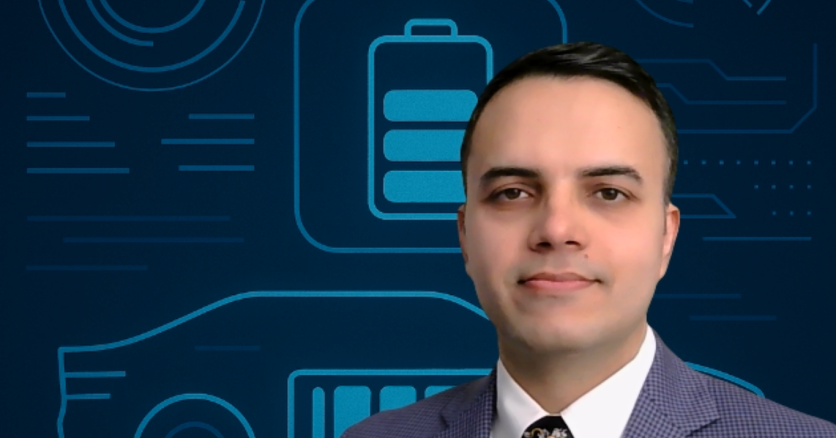
Electric vehicles (EVs) are transforming the automotive industry, offering cleaner, more sustainable alternatives to traditional cars. But even as the technology behind them continues to advance rapidly, battery systems remain one of the most technically sensitive parts of EVs. A single fault—whether thermal, chemical, or mechanical—can lead to a range of serious performance issues.
Systems Engineer Amardeep Sidhu has been working to reduce these risks for the past decade. From his graduate research in battery diagnostics to his current role as a System Safety Team Leader at Magna Electronics, his career has been focused on improving how EVs detect and respond to battery faults before they become serious problems. His approach centers on model-based diagnostics, which use mathematical models to define expected battery behavior.
Read on to learn more about how Amardeep's work is helping the automotive industry move beyond reactive fixes toward smarter, preventive safety systems.
Rethinking Battery Fault Detection with Model-Based Testing
Amardeep Sidhu first became interested in battery systems during his Master's in Mechanical Engineering at Purdue University, where he specialized in Mechatronics. His research focused on lithium-ion batteries, the core power source for EVs, and how faults in these systems are detected.
He found that traditional detection methods had critical limitations, with many systems either triggering alarms only after a problem had escalated or relying on fixed thresholds that didn't account for subtle variations in battery behavior. This meant early warning signs (like subtle voltage or temperature changes) were often missed. If left unchecked, these small irregularities would result in larger issues like overcharging, short circuits, or even thermal runaway—all of which can degrade performance, shorten battery life, or even cause full system failure.
In search of a better solution, Amardeep turned to model-based diagnostics, which uses mathematical models to define expected battery behavior under normal operating conditions by tracking variables like voltage, temperature, and current in real-time. Comparing these models with live sensor data from operating batteries allows engineers to spot subtle deviations early so they can act before they turn into larger problems.
This method has already proven effective, with studies indicating that model-based diagnostics can improve fault detection rates by over 46% and also reduce false alarms.
For Amardeep, learning about this approach changed how he viewed engineering. He began to see fault detection not just as a technical challenge, but as an essential part of designing systems that have a tangible impact on safety and everyday life.
That led him to pursue a second Master's, this time in System Design and Management at MIT, where he expanded his focus to systems thinking and safety frameworks: "I realized during my studies that even small improvements in how we detect faults or design safety systems can have a huge impact on people's lives."
Amardeep's Role in Advancing Automotive Systems
Today, Amardeep implements these testing frameworks as a System Safety Team Leader at Magna Electronics, a leading OEM supplier developing core technologies for automated and autonomous driving. His role involves ensuring that EV systems meet rigorous safety standards, from battery performance and charging systems to how vehicles detect and respond to faults.
Although his primary focus is on the vehicle's "brains" (the integrated software and hardware that enable automated and autonomous driving), his work remains closely tied to the battery and powertrain, as these systems must operate together to ensure seamless functionality across the entire vehicle. "Safety and performance are often in tension," he explains. "Balancing the two is one of the core challenges in advanced vehicle systems."
Beyond his work at Magna, Amardeep has made significant contributions to advancing automotive safety standards. He played a key role in developing two newly released industry standards that establish best practices for automotive safety and systems engineering, and also holds a patent for a safety feature that uses digital maps and onboard sensors to ensure advanced driver-assistance systems (ADAS) only activate when conditions are safe—preventing the vehicle from making decisions in risky situations.
Through these initiatives, Amardeep is helping define how electric and autonomous vehicles can be built with safety at the center: "Over the years, I've worked on technologies that make these vehicles not just possible, but safer for everyday life."
Teaching Engineers to Design for Safety
Amardeep's commitment to making advanced safety frameworks standard practice goes beyond the systems he helps design—he is also dedicated to educating future engineers.
He has contributed to the development of large-scale training efforts like MIT xPRO's Systems Engineering program, which trains professionals from organizations such as Boeing, General Motors, and the U.S. Navy. The courses he's helped design focus on model-based systems engineering (MBSE), fault diagnostics, and system safety modeling—giving mid-career engineers practical methods they can immediately apply to real-world systems.
So far, the programs shaped by Amardeep's contributions have reached more than 7,000 professionals across over a thousand organizations—a scale he sees as essential to expanding these practices beyond R&D teams and into day-to-day engineering workflows.
"These professionals take what they learn and apply it to real-world challenges across sectors like Aerospace, Automotive, Tech, and Healthcare," he concludes. "It's a reminder that education, when grounded in real-world practice, can be a powerful catalyst for transformation at both the individual and organizational level."
A Safer Future Starts with Smarter Models
Battery diagnostics might seem like a niche corner of engineering, but for Amardeep Sidhu, it's a critical aspect of improving the safety of EV systems. Through his work at Magna Electronics, his efforts to establish safety standards, and his work developing training programs for future engineers, he's helping make model-based diagnostics a standard in the industry—enabling engineers to detect subtle issues earlier, address them more effectively, and prevent the kinds of failures that can compromise performance or safety.
As the automotive industry transitions toward electrification, Amardeep's work is a reminder that this shift isn't just about building better batteries—it's about implementing smarter, preventive diagnostic systems that make electric vehicles as reliable and effective as they can.
ⓒ 2025 TECHTIMES.com All rights reserved. Do not reproduce without permission.




